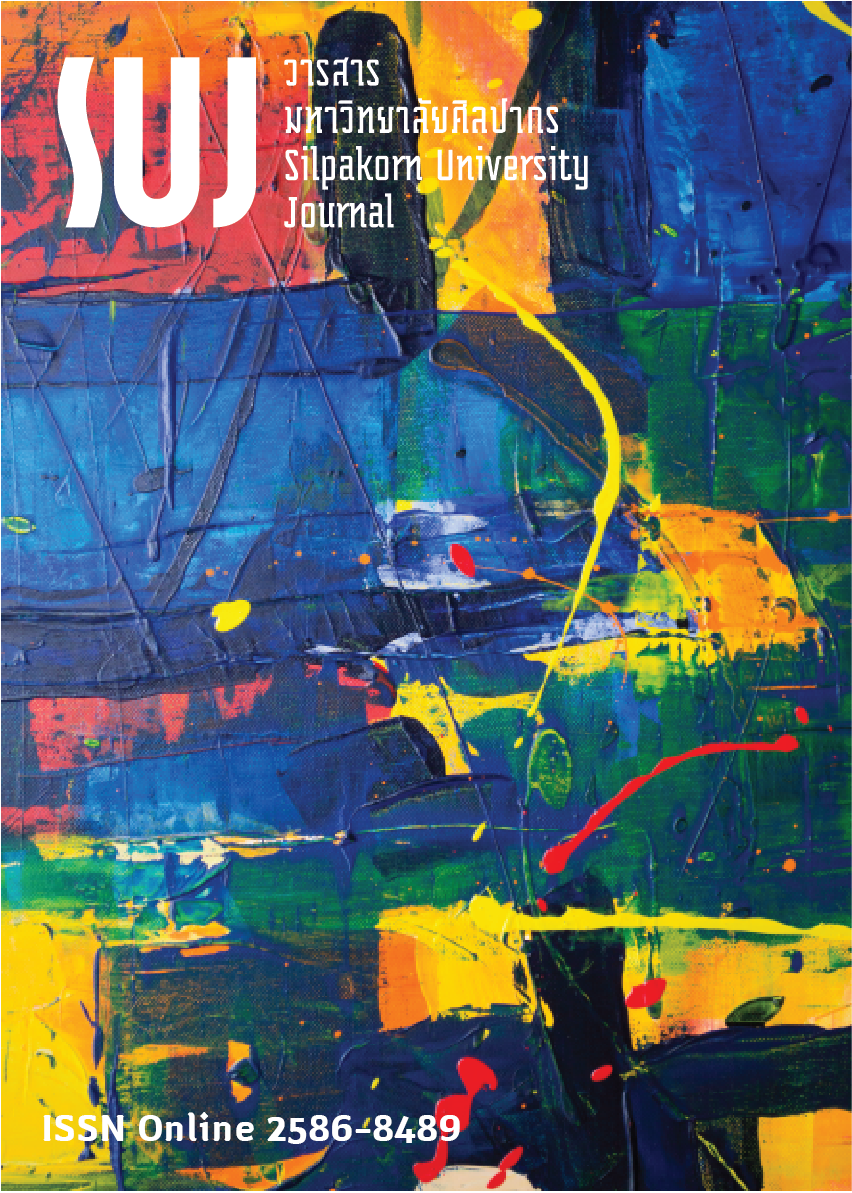ภาพสลักชิ้นเด่นจากปราสาทวัดพู: การศึกษาเรื่องประติมานวิทยาของภาพสลักประดับศาสนสถานที่ปราสาทวัดพู, สปป.ลาว (The iconographic study of architectural structure at Prasat Wat Phu temple, Laos PDR.)
Main Article Content
Abstract
ศาสนาพราหมณ์ ถือเป็นมรดกอารยธรรมจากชาวอินเดียที่ได้รับการนับถือปฏิบัติอย่างแพร่หลายในกลุ่มชุมชนโบราณ ซึ่งตั้งถิ่นฐานอยู่ในแถบภูมิภาคลุ่มแม่น้ำโขงตอนล่างมาเป็นเวลายาวนาน และ ยังเป็นแรงบันดาลใจในการสร้างสรรค์ งานศิลปกรรมทางศาสนา คติความเชื่อ และ ขนบธรรมเนียม ต่างๆ โดยถือเป็นรากฐานทางวัฒนธรรม ซึ่งเชื่อมโยงกลุ่มชุมชน ที่มีความหลากหลายทางชาติพันธุ์ให้เป็นอันหนึ่งอันเดียวกันในด้านวัฒนธรรมทางศาสนา และ งานศิลปกรรมแขนงต่างๆ
ปราสาทวัดพู เป็นโบราณสถานแบบเขมร ซึ่งเป็นมรดกโลกแห่งที่สองของประเทศลาว ตั้งอยู่บนเนินเขาภู หรือเรียกกันว่าภูควาย ห่างจากตัวเมืองเก่าจำปาสักประมาณ 6 กิโลเมตร ปราสาทวัดพูได้รับการรับรอง และขึ้นทะเบียนจากองค์การ UNESCO ให้เป็น เมืองมรดกโลก เนื่องจากความสำคัญทางด้านศิลปะและ สถาปัตยกรรม ซึ่งนอกจากจะประกอบด้วยความงามทางศิลปะแล้ว ยังสามารถสะท้อนให้เห็นถึงคติความเชื่อทางศาสนาพราหมณ์ ที่ได้รับการนับถือแพร่หลายเป็นอย่างยิ่งในช่วงที่ได้รับอิทธิพลทางศิลปะ และ ศาสนา จาก อาณาจักรกัมพูชาโบราณ ตั้งแต่ราวพุทธศตวรรษที่ 12 จนถึง พุทธศตวรรษที่ 18
บทความเรื่อง ภาพสลักชิ้นเด่นจากปราสาทวัดพู : การศึกษาเรื่องประติมานวิทยาของภาพสลักประดับศาสนสถานที่ปราสาทวัดพู มุ่งเน้นศึกษาเกี่ยวกับ ตำนานเทวนิยาย และ ประติมานวิทยาของเทพเจ้าในศาสนาพราหมณ์ซึ่งปรากฏบนเครื่องประดับศาสนสถานที่ปราสาทวัดพู กำหนดอายุทางศิลปกรรมอยู่ ในช่วงพุทธศตวรรษที่ 16-18 โดยใช้การเก็บข้อมูลภาคสนาม การศึกษาเปรียบเทียบทางด้านประวัติศาสตร์ศิลปะ และ ประติมานวิทยา แสดงให้เห็นถึง การเจริญขึ้นอย่างต่อเนื่องของการนับถือศาสนาพราหมณ์ในบริเวณพื้นที่ราบลุ่มแม่น้ำโขงตอนล่าง ซึ่งเป็นดินแดนที่ประกอบด้วยความหลากหลายทางชาติพันธุ์ และ วัฒนธรรม อันเนื่องมาจากสภาพภูมิประเทศซึ่งเป็นเขตติดต่อระหว่างภาคตะวันออกเฉียงเหนือของประเทศไทย แขวงจำปาสัก ในประเทศลาว และ ตอนเหนือของประเทศกัมพูชา ด้วยเหตุนี้ ปราสาทวัดพู จึงถือเป็นมรดกทางวัฒนธรรมที่สำคัญมากแห่งหนึ่ง นอกจากคุณค่าความงามทางด้านสถาปัตยกรรม และ ศิลปกรรมแล้ว ภาพสลักเรื่องราวทางศาสนาพราหมณ์ และ ประติมากรรม ยังสามารถสะท้อนให้เห็นถึง คติความเชื่อทางศาสนาที่ได้รับการนับถือแพร่หลาย และ เป็นรากเหง้าทางวัฒนธรรมของชุมชนโบราณในภูมิภาคแห่งนี้อีกด้วย
Brahmanism is regarded as Indian cultural heritage that was continuously in practice among the ancient cities located in the lower basin of the Mae Khong River. The Brahmanism also inspired the making of religious arts, folklore and other related traditions. Therefore, it is able to state that Brahmanism is cultural link binding the old cities with ethnical differences, creating their unity in religious culture and arts.
Prasat Wat Phu is an ancient Khmer monument that has been awarded the second World heritage of Laos PDR. The temple is located at the hilly area of Phu Kway Mountain, 6 km. from old Champasak city. Wat Phu is awarded and recognized as World Heritage by UNESCO owing to its artistic and architectural significance. In addition to the temple artistic value, the monument also reflects the trace of Brahmanism which once was well known and widely practiced in this region. Archaeological evidence stated that the rise of Brahmanism during 6th-12th century A.D. was influenced by ancient Khmer tradition.
This article mainly concentrated on the Brahmanical mythology and iconography depicted at the architectural structures mainly dated from 10th-12th century A.D. The research methodology was field survey and comparative study of arts and iconography. The result of study shows the gradual development of Brahmanism in lower Mae Khong Basin, where a variety of ethnical groups flourished due to the geographic features as it was a border area of the northeast of Thailand, Champasak District of Laos and the north of Cambodia. Thus, Prasat Wat Phu is one of the crucial cultural heritage. Apart from the architectural and artistic value, the stone carving of Brahmanical stories and sculptors reflected the widely practiced religious beliefs and served as the cultural root of the ancient communities in this region.
Downloads
Article Details
References
Aoeanand, Malichatra. (2002). Dictionary of Arts (พจนานุกรมศัพท์ศิลปะ). Bangkok: Chulalongkorn University Publisher.
Bhandarkar, R. G. (1928). Vaisnavism, Saivism and minor religious systems. Poona: Bhandarkar Oriental Research Institute.
Bhattacharya, K. (1961). Les Religions Brahmaniques dans L’Ancien Cambodge. Paris: École française d’Extrême-Orient.
Byant, F. E. (2004). Bhagavata Purana “Krishna: the Beautiful Legend of God”. London: Penguin Classic Book.
Coedès, G. (1948-68). Les Etats Hindouises d’ Indochine et d’ Indonesie. (1st ed). Paris: E de Boccard.
Dallapiccola, A. (2002). Dictionary of Hindu Lore and Legend. London: Theme & Hudson.
Dissakul, Subhadradis, M.C. (1992). History of Southeast Asia before 15th century (ประวัติศาสตร์เอเชียอาคเนย์ ถึง พ.ศ. 2000). Bangkok: the council of Historical study.
Dissakul, Subhadradis, M.C. (1996). Khmer Arts (ศิลปะขอม). Bangkok: Khurusapa.
Dissakul, Subhadradis, M.C. (2004). The Brahmanism in Ancient Cambodian Kingdom (ศาสนาพราหมณ์ในอาณาจักรขอม. (21nd ed). Bangkok: Mathichon.
Filliozart, Vasundhara. (2004). Pasupati Saivism in Karnataka and Cambodia. Siksacakr journal of Center for Khmer Studie, 4(1): 24-27.
Gonda, J. (1966). Ancient Indian Kingship from the religious point of view. Laiden: B.J. Brill.
Parmentier, H. (1914). Le temple de Vat Phou. Bulletin de l’Ecole française d’Extrême-Orient, 14(2): 1-31.
Patil, S. H. (2002). Community Dominance and Political Modernisation: The Lingayats. Delhi: Mittal Publication.
Petchanaga, Orawan. (2012). Believes and Arts of lintels at Prasat wat Phu temple, Laos PDR. (คติความเชื่อและรูปแบบของภาพสลัก ปราสาทวัดพู แขวงจำปาสัก สปป.ลาว). Master’s dissertation, Khon Kaen University, Khon Kaen, Thailand.
Rao, T. A. G. (1914-16). The Element of Hindu Iconography, (I-IV). Madras: Law Printing House.
Roveda, V. (2005). Images of Gods : Khmer mythology in Cambodia, Thailand and Laos. Bangkok: Riverbook.
Wolters, O. W. (2000). A Hindu man or prowess. History Culture and Region in Southeast Asian Perspectives. Ithaka: ISEAS/Cornell Southeast Asia Program Publications.


